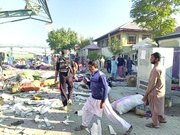Speaking at the opening ceremony of the second conference of the OIC’s health ministers, Ali-Akbar Salehi averred, “Malaria causes about one million deaths in the world yearly,” mostly among those living in less-developed countries.
“A number of 500 millions in the world suffer from the disease,” Salehi said.
Referring to the world program to combat malaria and tuberculosis, OIC’s deputy secretary general stressed that the less-developed countries are most at risk of AIDS and Malaria pandemic.
He also referred to the big improvements in eradicating polio disease, saying there was a great decrease in number of polio sufferers worldwide.
“The number has reached 400,000 in 2001,” Salehi added.
Expressing concern over the high infant death rate in six out of ten Islamic countries, he said that the number has reached zero in developed countries.
The number of maternal deaths per 100,000 live births is 2,000 in some Islamic countries, he lamented.
Describing infectious diseases and poliomyelitis as the main causes of child and maternal death in the Islamic countries, Salehi stressed the need for greater cooperation of the Islamic countries in establishing a health system.
He called for further expansion of ties between the Islamic countries in a bid to provide more health services to infants and mothers.
The OIC’s member states signed an agreement in Mecca in 2005.
It also inked a Memorandum of understanding with U.S. Centers for Disease Control and Prevention (CDC) in December 2008.
The CDC is an agency of the United States Department of Health and Human Services.
Malaria is caused by parasites of the species Plasmodium. The parasites are spread to people through the bites of infected mosquitoes.
According to WHO, a child dies of malaria in every 30 seconds and in 2006, there were 247 million cases of malaria, causing about 880,000 deaths, mostly among African children.
Malaria, which is a life-threatening disease, is preventable and curable. Travelers from malaria-free areas to disease "hot spots" are especially vulnerable to the disease.
It takes an economic toll -- cutting economic growth rates by as much as 1.3% in countries with high disease rates.
SN/PA
MNA
END




















Your Comment